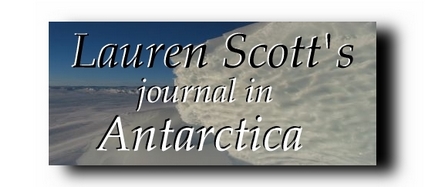|
Updating quicklook software and a day cut short
The weather looked rather ominous right off
the bat today. By the time we got out to Willy Field, you could
barely see Mount Erebus off in the distance, due to the cloud
cover. Within a few hours, we learned that Garry and the ANITA
crew were still delayed in Christchurch. Dana continued to work
on the thermal shielding and I began to refamiliarize myself with the
quicklook software that I started working on when we were in Palestine
doing our mechanical integration testing this past June and July.
During a balloon flight like this, some sort of quicklook routine is
important to make sure that the instrument's voltages, currents,
temperatures and data look correct over the time of the flight.
As lunch rolled around, it had begun to snow a
little. Despite what you might imagine, snowfall around here is
actually rather rare, since Antarctica is actually the largest desert
in the world. The climate is extremely dry and most of the
precipitation occurs during this time of year (the Spring). Dave
Sullivan, the campaign manager, warned us that we might want to think
about heading into town before the worst of the storm hit. By
1:00, the winds had picked up to around 25 knots, with windchills
around -20°F or so.
In Antarctica, they measure the weather in three
conditions. Condition 3 is normal sunny weather with only light
winds. Condition 2 has limited visibility with winds that may
reach 30 - 35 knots. Condition 1 is when you can't see your hand
in front of your face, the winds can soar to extremely high speeds, and
you are required to stay where you are, whether it be in some sort of
shelter or in a vehicle. During times like this, the storm is
often known as a "herbie." I think that this is short for a
hurricane-blizzard. We were actually stranded out at the Williams
Field galley for about 4 hours two years ago during a condition
1. Needless to say, it was fantastic!
At 1:30, the voice over the radio from MacOps
(McMurdo operations) declared a condition 2. A shuttle came to
rescue us at about 2:00 and we headed back into town. Dana and I
used the opportunity to do some much-needed laundry. After
dinner, I went over to the coffee house to watch a movie about marine
biology research at McMurdo. It was filmed in the 1980s and so it
was interesting to see what has changed around here since then.
It featured the research of Art DeVries, a professor from the
University of Illinois Urbana/Champagne, who is almost a legend around
here. He has been coming to McMurdo for many years to dive and do
scuba research in the area.
There are all sorts of things to do here in the
evenings, really. As you stroll down "Highway 1," the main
hallway in building 155 which is the most heavily trafficked area in
MacTown, there are always fliers up featuring classes ranging from
ballroom dancing to plumbing, reading groups, movie nights and both
scientific and historical lectures.
|



